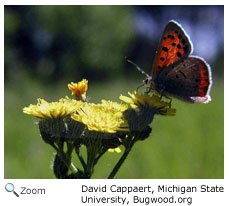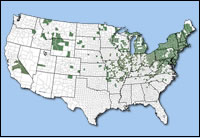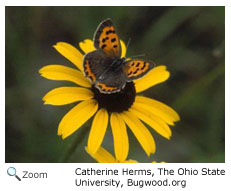American Copper - Lycaena phlaeas |
||||||
Description
Range |
HabitatLowland populations of American coppers are found in pastures, landfills, roadsides, yards, and fields. Arctic and alpine populations are found above the tree line on barren ground and talus slopes. A talus slope is a pile of rocks at the base of a cliff or slope. Diet Life Cycle
The male American copper perches in grassy areas and waits for a female. The female lays one egg at a time on the leaves of a host plant.
The American copper produces one to two broods a year. The caterpillar is
red to yellow-green and has red and white stripes. |
|||||


 Lowland groups of the American copper are found
from Nova Scotia, Canada south to Arkansas and Georgia, and west to North Dakota and Kansas. Arctic and alpine populations are found from Greenland west to Alaska and south to the Hudson Bay. American copper populations are also found in the mountains of some western states.
Lowland groups of the American copper are found
from Nova Scotia, Canada south to Arkansas and Georgia, and west to North Dakota and Kansas. Arctic and alpine populations are found from Greenland west to Alaska and south to the Hudson Bay. American copper populations are also found in the mountains of some western states.